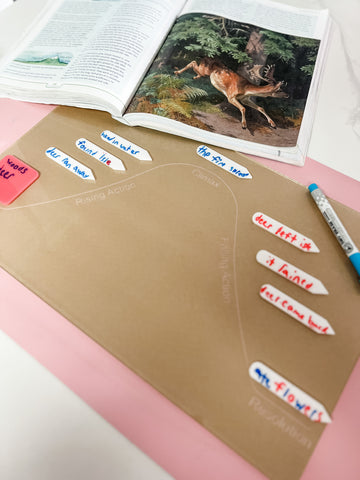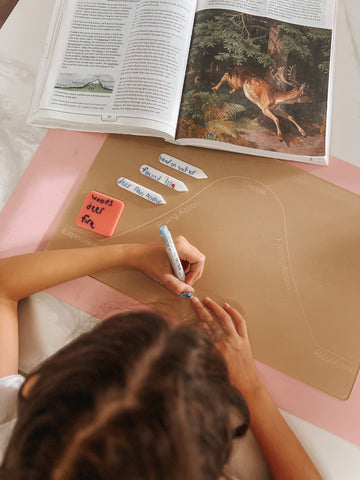Your Cart is Empty
OUR TURNAROUND ON ALL ORDERS IS 4 WEEKS BEFORE SHIPPING

Hi everyone! My name is Natasha and I'm going to share some fun language arts activities with you guys today.
One of the classic language arts activities is plotting a story.

This starts as soon as you read your baby their first book and continues all throughout the rest of their life! It starts off simple by asking about the characters in the story, asking where the story takes place, the events that happen throughout the story, and then asking what happens at the very end.
You don’t really learn until later that this whole process has a name. Well… many names. Dramatic Structure. Freytag’s Pyramid. Narrative Rollercoaster. Plot Arc. The list goes on.
The plot diagram is like a map for a story, guiding us from the exposition to the climax and finally to the resolution. It helps us understand the structure of a story and keeps us on track as we unfold all the twists and turns. Sometimes, it can be a little intimidating!
So what better way to help your children understand the structure of a story that by bringing your plot diagram to life?
Lately we’ve had the chance to dive a little deeper into the different elements of a story and have gotten good use out of our Jack and Link Plot Arc Dry Erase Board. The best part is that it can be tailored to older children andyounger children just by changing the writables that you use along with them.

For younger children, you can simply use a figure to represent the character in the story and move it along the plot diagram as you read the story. This can be a fun and interactive way to introduce them to the concept of storytelling without overloading them. You can even introduce the terminology, but you don’t need to worry about having them truly understand it. That’ll come with time and exposure!
With my first grader, we selected a Valentine book and read it together. As we read, I paused to ask the usual questions: Who is the story about? What is happening? What is the problem? We would then just move our little unicorn along the plot arc until we reached the resolution. No writing. No abstract concepts. No deep diving necessary. At this stage, we’re just introducing!

As they grow older, you can gradually introduce more complex elements of the plot diagram, allowing them to delve deeper into all of the intricacies of narrative structure.
This is what I did with my third grader.
First, we talked about the different elements of the plot arc. Then, as we read the story together, we would stop, talk, identify, and write. This is where you can make things a little more complex! Instead of just moving the figure, now you’re identifying key points in the story and writing them down. You’ll start to see your Plot Arc come to life! We used the labels to write down simple phrases that would help us remember key points in the rising and falling action, and a bigger square to write down some of the elements of the exposition.

So, whether you're working with an elementary, middle, or even high school student you can use the Plot Arc at all stages to help bring a story to life! You can follow me on my homeschool instagram account for more fun ideas @thevieccovault
Comments will be approved before showing up.